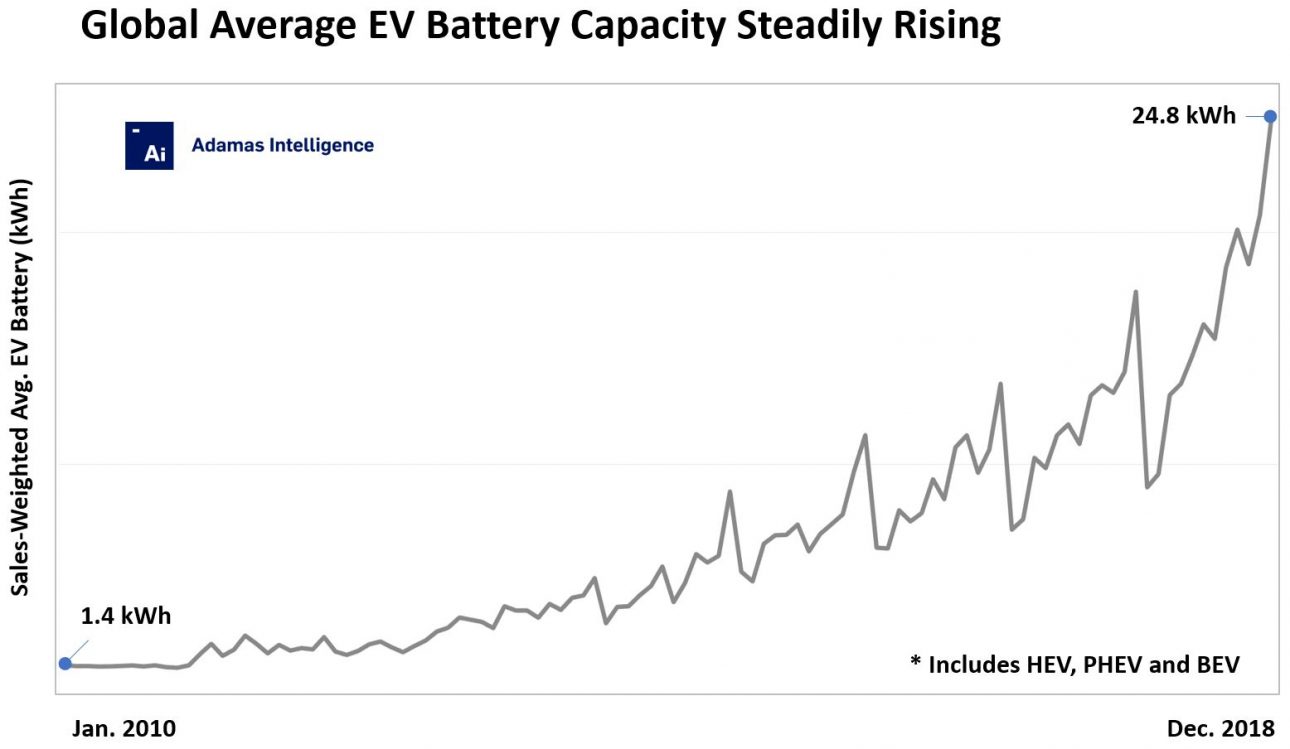Sales would not increase so fast without rapidly evolving products
According to Adamas Intelligence, sales of electrified passenger cars (hybrids, plug-in hybrids and all-electric) increased in 2018 by 28.6% to 4.28 million, at 5.2% of total global volume.
The new report notes that the market of electrified cars not only expands fast, but at the same time evolves even faster, which can be seen on all levels from models, to battery packs, to battery cells and even cell chemistry itself.
In the case of models – the market is evolving towards scalable modular platforms – some dedicated to handle different powertrains, and some dedicated for BEVs. It will be rare to see a new conventional model converted to electric just to have some compliance EV.
Average battery pack capacity is quickly growing from around 1.4 kWh (initially mostly hybrids) in January 2010 to 24.8 kWh in December 2018.
“The average EV pack capacity (in kWh) is continually increasing. This increase is happening for a number of reasons; such as advances in cell chemistry, greater sales of BEVs relative to HEVs, and due to an urgency on the part of automakers to expand driving range (distance per charge) so as to differentiate their EV model(s) from those of incumbents.
Overall, the global sales-weighted average EV battery capacity has increased by a factor of 18x in nine years, from 1.4 kWh in January 2010 to 24.8 kWh in December 2018 (see recent insight from Adamas Intelligence).”
The battery cells (in three main form factors – prismatic, pouch and cylindrical) also are changing to higher capacity versions and bigger size.
“As of 2019, the three main form factors (prismatic, pouch and cylindrical) continue to be widely used but if-and-when some cell suppliers do broadly adopt high-nickel NCM 811 (or other high-nickel NCM or NCA cathodes), cylindrical and pouch form factors will become the logical choice to accommodate the thermal expansion associated with these chemistries.
Although form factors haven’t evolved much in recent years, the sales-weighted average cell volume and capacity continues to expand, as reflected by Tesla’s switch from 18650 to 21700 cylindrical cells, as well as CATL’s shift from 45Ah to 50Ah prismatic cells, and beyond.”
Adamas Intelligence said that the total deployment of batteries in electrified passenger cars (including hybrids) was in 2018 72.3 GWh (up 81% year-over-year from 40 GWh in 2017).
Nickel-rich cathodes are on the rise:
Lastly, at the cell chemistry level, the landscape is rapidly moving towards ‘higher’ nickel cathode varieties (i.e. NCM 523/622) but remains broadly cautious of adopting the ‘highest’ nickel varieties (i.e. NCM 811) due to cost, reliability and safety concerns.
In 2018, global deployment of NCM 523 (in GWh) for passenger EVs increased 129% year-over-year and deployment of NCM 622 increased 230% year-over-year while global deployment of NCM 811 among first movers decreased 46% year-over-year (see recent insight from Adamas Intelligence).

Source: Adamas Intelligence

